Notes: Saddleworth is a large parish occupying the upper valley of the River Tame and its tributaries and extending onto the surrounding bleak Pennine moorlands. Until the regrettable adjustments to British administrative geography of 1 April 1974 Saddleworth lay within the West Riding of Yorkshire and the parish was bounded to the west and south by Lancashire and to the east by Cheshire. Although the old counties were not abolished, for administrative purposes – and shown on Ordnance Survey maps and their derivatives – there was a new pattern of counties. Saddleworth was allocated to the newly created Metropolitan County of Greater Manchester: it was an insensitive decision considering the longstanding rivalry, even enmity, between Yorkshire and Lancashire to place Saddleworth in the orbit of what had been Lancashire’s principal city. Since 1 April 1986, when the ‘new’ Metropolitan Counties were effectively abolished, Saddleworth has been administered by the Metropolitan Borough of Oldham, itself within the former Greater Manchester.
The parish of Saddleworth is unusual in that there is no specific settlement which bears this name although there are a few other examples of this phenomenon in the southern and central Pennines, such as Cliviger (see the Copy Pit route pages on the Disused Stations website) and Old Laund Booth, both in Lancashire. Saddleworth consists of a few settlements of almost urban character, notably Delph and Uppermill, and numerous villages, hamlets and isolated dwellings.
 When the Huddersfield & Manchester Railway opened to passengers on 1 August 1849 two of the stations were within the parish of Saddleworth; one was named Greenfield and the other Saddleworth. In the LNWR timetable of 1852 Saddleworth was named ‘Saddleworth Upper Mill’ but by 1864 this timetable had dropped ‘Upper Mill’ from the name. On the same route Diggle(also within the parish) was added in 1850. In 1851 a further station opened in the parish at Delph, the terminus of a short branch from Greenfield, with Grotton following in 1857 on the new Greenfield – Oldham line. By 1871 there were five stations within the parish of Saddleworth, and in that year Joseph Bradbury commented in his Saddleworth Sketches (1871) that the situation caused confusion to those who were unaware that Saddleworth station, despite its name, did not serve the whole of Saddleworth. In his account, passengers would book journeys to Saddleworth station, and realise on arrival that they were several miles from their anticipated destination. Likewise, goods would be sent mistakenly to Saddleworth station, when this was inconvenient for many recipients. Bradbury concluded that, despite the clarity a name change would provide, ‘it may fairly be doubted if anything short of Her Majesty's warrant could change it from Saddleworth to Brownhill station’. By 1890 there were seven stations in the parish, and by 1932, when Measurements Halt opened on the Delph branch there had been 11 stations (including halts) in the parish; two of them (Uppermill and Friezland) had closed to passengers before the end of World War 1. When the Huddersfield & Manchester Railway opened to passengers on 1 August 1849 two of the stations were within the parish of Saddleworth; one was named Greenfield and the other Saddleworth. In the LNWR timetable of 1852 Saddleworth was named ‘Saddleworth Upper Mill’ but by 1864 this timetable had dropped ‘Upper Mill’ from the name. On the same route Diggle(also within the parish) was added in 1850. In 1851 a further station opened in the parish at Delph, the terminus of a short branch from Greenfield, with Grotton following in 1857 on the new Greenfield – Oldham line. By 1871 there were five stations within the parish of Saddleworth, and in that year Joseph Bradbury commented in his Saddleworth Sketches (1871) that the situation caused confusion to those who were unaware that Saddleworth station, despite its name, did not serve the whole of Saddleworth. In his account, passengers would book journeys to Saddleworth station, and realise on arrival that they were several miles from their anticipated destination. Likewise, goods would be sent mistakenly to Saddleworth station, when this was inconvenient for many recipients. Bradbury concluded that, despite the clarity a name change would provide, ‘it may fairly be doubted if anything short of Her Majesty's warrant could change it from Saddleworth to Brownhill station’. By 1890 there were seven stations in the parish, and by 1932, when Measurements Halt opened on the Delph branch there had been 11 stations (including halts) in the parish; two of them (Uppermill and Friezland) had closed to passengers before the end of World War 1.
 The stations between Huddersfield and Stalybridge were described by the Manchester Examiner as being ‘in the Tudor style’ and that they ‘will have a picturesque effect when completed; the pointed architecture harmonises so well with the abrupt pointed scenery around’. This description applies to Saddleworth inasmuch as its principal building was picturesque, and it harmonised with the scenery around by virtue of being constructed of local sandstone; however it was the blackened masonry – the product of decades of smoke-polluted air – that provided harmony with all of the stone buildings throughout the upper Tame valley. The station’s character was distinctly rural in comparison to the others on the line which were provided with substantial platform roofing. The stations between Huddersfield and Stalybridge were described by the Manchester Examiner as being ‘in the Tudor style’ and that they ‘will have a picturesque effect when completed; the pointed architecture harmonises so well with the abrupt pointed scenery around’. This description applies to Saddleworth inasmuch as its principal building was picturesque, and it harmonised with the scenery around by virtue of being constructed of local sandstone; however it was the blackened masonry – the product of decades of smoke-polluted air – that provided harmony with all of the stone buildings throughout the upper Tame valley. The station’s character was distinctly rural in comparison to the others on the line which were provided with substantial platform roofing.
The main building, constructed of local sandstone, adjoined the down (Huddersfield-bound) platform and possessed considerable charm. The upper (attic) storey of the central section, containing the stationmaster’s house, was aligned at right angles to the platform, its steeply-pitched, overhanging slate roof emphasised by decorated deep bargeboards with a pendant at their apex. A canted bay on the ground floor faced the platform. Single-storey wings extended either side of the central section, both with steeply pitched, overhanging roofs. A timber structure, with its own pitched roof, stood in front of the southern wing, the roof distinguished by contrasting bands of plain and fish-scale slates; it was partly enclosed with a glass and timber screen as a waiting room and partly open as a passenger shelter. At one time the northern wing carried a decorated bargeboard of a different design to the style used on the main gable, but in later years this was removed and a plain one replaced it. To those approaching the station by the curving drive, the stationmaster’s house with its steeply-pitched roof and elaborate bargeboards and the well-proportioned wings extending on either side would appear both attractive and impressive. At Greenfield, the next station south of Saddleworth, the elevated entrance building included a gable and decorated bargeboard similar to that at Saddleworth.
 The station’s signal box was at first located on the down platform north-east of the passenger buildings; however this was replaced with a box south-west of the buildings as seen on the accompanying photographs. The station’s signal box was at first located on the down platform north-east of the passenger buildings; however this was replaced with a box south-west of the buildings as seen on the accompanying photographs.
On the up platform were two timber structures of modest size. The larger building resembled the timber addition to the main building, its pitched roof similarly formed of plain and fish-scale slates; it contained a booking office and an open waiting shelter with a very long bench. The smaller, very plain building - again under a pitched slate roof - was used as the ladies’ waiting room and toilet.
North of the passenger station, on the down side of the railway, were a stone-built goods shed and a cattle dock served by two sidings which trailed from points on the down line. The Railway Clearing House Handbook of 1904 records that the station could handle livestock, horse boxes and prize cattle vans and that a 1 ton 10 cwt capacity crane was installed. However, unlike many stations it was unable to handle ‘furniture vans, carriages, portable engines and machines on wheels’. From 1 July 1921 Saddleworth’s goods facilities ceased to handle any traffic other than coal; such ‘downgrading’ was unusual, but there were larger goods depots nearby at Uppermill and Friezland on the Micklehurst Loop (the parallel line which served as the third and fourth tracks of the Manchester-Huddersfield route between Stalybridge and Diggle) and they would remain in use until the 1960s.

Access to the station building and down platform at Saddleworth was by means of the drive from Wool Road as well as by a path from both Wool Road and Brownhill Lane. For many years there was no access to the up platform except by crossing the line from the down platform. Because of the pronounced curve of the railway through Saddleworth station it was hazardous to cross the lines, and Wells (1996) reports a serious accident which illustrates the point. On 10 July 1880 the Mossley & Saddleworth Reporter referred to a ‘shocking accident’ in which an eleven-year-old girl, Elizabeth Brunsett of Diggle, was almost killed: ‘It appears that as the girl was about to cross the line round the back of the 2.20 o’clock train from Leeds to Manchester … the fast train from Manchester to Leeds … which does not stop at Saddleworth, came up and knocked her down’. In March 1882 the newspaper reported that the girl was awarded £50 by the LNWR and condemned the dangerous means of crossing the line: ‘There was no gate which might be closed in order to warn people that a train was coming or leaving. Indeed, there was no place marked for the purpose over the line except two or three small steps purposely made small to allow the carriages to clear them’. No footbridge or subway was ever provided to connect the platforms at Saddleworth station, but eventually the LNWR provided a path to the up platform from Brownhill Lane.
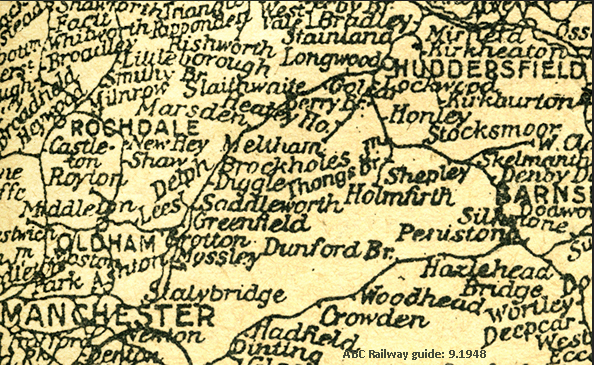
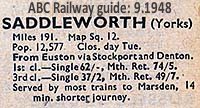 The Huddersfield – Manchester railway was originally double track (although, at first, single through Standedge Tunnel) but the volume of passenger, goods and mineral traffic grew to such a degree that the LNWR decided to add two more tracks. The sides of the Colne Valley between Huddersfield and the Standedge Tunnels were steep and, in places, built upon, but it was possible to quadruple this section and provide two additional platform faces at Longwood, Golcar, Slaithwaite and Marsden stations; this work was done between 1883 and 1894. An additional double-track bore was added to the two existing single-track Standedge Tunnels and at Diggle station (immediately south-west of the Standedge Tunnels) space was available to create four platform faces. However between Diggle and Stalybridge, through Saddleworth, Greenfield and Mossley stations, the railway clung to the steep western slope of the Tame valley, and industry and housing crowded the route so closely that it was impossible to add two extra railway tracks without extensive demolition and expensive engineering. The solution was to construct a new 6¾-mile route on the eastern side of the Tame valley skirting the settlements already served by Saddleworth, Greenfield and Mossley stations on the original line. This new line, known as the Micklehurst Loop, opened in July 1886. On the loop, Uppermill station effectively acted as Saddleworth station’s third and fourth platforms and it was better placed than Saddleworth to serve the small town after which it was named. Uppermill station’s superior goods facilities, including a commodious shed, may explain why from 1 July 1921 Saddleworth station ceased to handle any goods traffic other than coal. The goods yards and sheds at both Uppermill and Friezland, the next station south on the Micklehurst Loop, were in use until the 1960s. The Huddersfield – Manchester railway was originally double track (although, at first, single through Standedge Tunnel) but the volume of passenger, goods and mineral traffic grew to such a degree that the LNWR decided to add two more tracks. The sides of the Colne Valley between Huddersfield and the Standedge Tunnels were steep and, in places, built upon, but it was possible to quadruple this section and provide two additional platform faces at Longwood, Golcar, Slaithwaite and Marsden stations; this work was done between 1883 and 1894. An additional double-track bore was added to the two existing single-track Standedge Tunnels and at Diggle station (immediately south-west of the Standedge Tunnels) space was available to create four platform faces. However between Diggle and Stalybridge, through Saddleworth, Greenfield and Mossley stations, the railway clung to the steep western slope of the Tame valley, and industry and housing crowded the route so closely that it was impossible to add two extra railway tracks without extensive demolition and expensive engineering. The solution was to construct a new 6¾-mile route on the eastern side of the Tame valley skirting the settlements already served by Saddleworth, Greenfield and Mossley stations on the original line. This new line, known as the Micklehurst Loop, opened in July 1886. On the loop, Uppermill station effectively acted as Saddleworth station’s third and fourth platforms and it was better placed than Saddleworth to serve the small town after which it was named. Uppermill station’s superior goods facilities, including a commodious shed, may explain why from 1 July 1921 Saddleworth station ceased to handle any goods traffic other than coal. The goods yards and sheds at both Uppermill and Friezland, the next station south on the Micklehurst Loop, were in use until the 1960s.
Up trains: weekdays
March 1850 |
Destination |
Down trains: weekdays |
Destination |
7.55am |
Manchester |
7.22am |
Leeds |
8.33am |
Manchester |
9.27am |
Leeds |
10.40am |
Manchester |
11.05am |
Leeds |
12.25pm |
Manchester |
1.52pm |
Leeds |
4.20pm |
Manchester |
3.50pm |
Leeds |
7.00pm $ |
Stalybridge |
6.07pm |
Leeds |
7.22pm |
Manchester |
9.22pm |
Leeds |
9.47pm |
Manchester |
- |
- |
Up trains: Sunday |
Destination |
Down trains: Sunday |
Destination |
7.42am |
Manchester |
9.02am |
Leeds |
2.42pm |
Manchester |
2.52pm |
Leeds |
8.25pm |
Manchester |
9.22pm |
Leeds |
$ Tuesday, Thursday and Saturday only: train starts here
All trains call at Saddleworth (but run fast through some other stations)
 In its early years Bradshaw timetables indicated that Saddleworth was one of the more important stations between Leeds and Manchester using bold type for the name and indicating (in the March 1850 edition) that all trains called, which was not the case for some of the other intermediate stations. The service of seven weekday and three Sunday trains (plus one which ran only on Tuesday, Thursday and Saturday only) was spaced fairly evenly throughout the day. The February 1863 and August 1887 timetables showed a similar frequency of service. As seen below by April 1910 the weekday level of service had improved. In its early years Bradshaw timetables indicated that Saddleworth was one of the more important stations between Leeds and Manchester using bold type for the name and indicating (in the March 1850 edition) that all trains called, which was not the case for some of the other intermediate stations. The service of seven weekday and three Sunday trains (plus one which ran only on Tuesday, Thursday and Saturday only) was spaced fairly evenly throughout the day. The February 1863 and August 1887 timetables showed a similar frequency of service. As seen below by April 1910 the weekday level of service had improved.
Up trains: weekdays
April 1910 |
Destination |
Down trains: weekdays |
Destination |
5.10am (Starts here) |
Manchester Exchange |
5.39am |
Leeds New |
7.26am |
Stalybridge |
7.40am |
Leeds New |
8.09am |
Manchester Exchange |
8.24am |
Leeds New |
8.45am |
Manchester Exchange |
9.35am |
Huddersfield |
10.20am |
Manchester Exchange |
10.21am |
Huddersfield |
10.48am |
Manchester Exchange |
11.21am |
Leeds New |
12.56pm |
Manchester Exchange |
12.39pm |
Leeds New |
2.01pm |
Manchester Exchange |
1.42pm |
Leeds New |
3.18pm |
Manchester Exchange |
3.55pm |
Huddersfield |
5.09pm |
Manchester Exchange |
5.00pm |
Huddersfield |
5.50pm |
Manchester Exchange |
6.00pm |
Huddersfield |
6.35pm |
Stalybridge |
6.41pm |
Huddersfield |
8.00pm |
Manchester Exchange |
7.31pm |
Leeds New |
9.49pm |
Manchester Exchange |
8.59pm |
Hull |
- |
- |
10.21pm |
Leeds New |
- |
- |
11.50pm $ |
- |
Up trains: Sunday |
Destination |
Down trains: Sunday |
Destination |
8.05am |
Manchester Exchange |
10.48am |
Leeds New |
1.40pm |
Manchester Exchange |
7.27pm |
Leeds New |
8.14pm |
Manchester Exchange |
9.57pm |
Leeds New |
9.17pm |
Manchester Exchange |
- |
- |
$ Tuesday, Thursday and Saturday only: arrival from Manchester Exchange terminates here
Several trains run via Micklehurst Loop, calling at Uppermill station (close to Saddleworth station)
 The station carried nameboards reading ‘Saddleworth for Dobcross’ for some time until the early years of the twentieth century, and Bradshaw timetables gave the station name in this form. However in 1912 the LNWR added three stations to be served by Delph – Greenfield – Oldham trains, and one of these was Dobcross on the Delph branch (which left the main line a short distance south of Saddleworth station). Thereafter ‘Dobcross’ was dropped from Saddleworth’s name, but it is not known how long it was before the station nameboards were altered or replaced. The station carried nameboards reading ‘Saddleworth for Dobcross’ for some time until the early years of the twentieth century, and Bradshaw timetables gave the station name in this form. However in 1912 the LNWR added three stations to be served by Delph – Greenfield – Oldham trains, and one of these was Dobcross on the Delph branch (which left the main line a short distance south of Saddleworth station). Thereafter ‘Dobcross’ was dropped from Saddleworth’s name, but it is not known how long it was before the station nameboards were altered or replaced.
As seen elsewhere in Britain, although competition from road transport was coaxing passengers from the railways, in the late 1930s some of the most intensive services of passenger trains were provided; the departures from Saddleworth station (see below) illustrate this, with no fewer than 17 Monday-to-Friday and 20 Saturday northbound calls.
Up trains: weekdays
July 1938 |
Destination |
Down trains: weekdays |
Destination |
6.02am MX |
Stalybridge |
6.05am |
Leeds City § |
6.46am |
Manchester Exchange |
7.01am |
Leeds City |
7.10am SX |
Stalybridge |
7.23am |
Huddersfield |
7.10am SO |
Manchester Exchange |
8.11am |
Leeds City |
8.03am |
Manchester Exchange |
9.32am |
Huddersfield |
8.33am |
Stalybridge |
10.44am |
Leeds City |
9.03am |
Manchester Exchange |
11.33am SX |
Huddersfield |
9.57am |
Manchester Exchange |
11.33am SO |
Leeds City § |
11.00am |
Manchester Exchange |
12.40pm |
Leeds City |
12.12pm SO |
Manchester Exchange |
1.24pm SO |
Huddersfield |
12.24pm SO |
Manchester Victoria |
1.33pm |
Leeds City |
12.37pm SO |
Greenfield |
2.36pm |
Leeds City § |
1.01pm |
Manchester Exchange |
3.50pm |
Huddersfield |
1.55pm |
Manchester Exchange |
4.48pm |
Huddersfield |
3.05pm |
Manchester Exchange |
6.11pm |
Leeds City |
5.07pm |
Manchester Exchange |
6.42pm |
Leeds City § |
5.45pm |
Manchester Exchange |
7.43pm |
Leeds City |
6.31pm |
Stalybridge |
9.00pm |
Leeds City |
7.45pm |
Manchester Exchange |
10.02pm SO |
Leeds City § |
9.42pm |
Manchester Exchange |
10.51pm |
Leeds City |
11.36pm SO |
Oldham Clegg Street |
11.50pm SO |
Marsden |
Up trains: Sunday |
Destination |
Down trains: Sunday |
Destination |
8.18am |
Manchester Exchange |
8.33am |
Leeds City |
11.57am |
Manchester Exchange |
11.02am |
Huddersfield |
1.27pm |
Manchester Exchange |
5.42pm |
Leeds City |
6.31pm |
Manchester Exchange |
9.21pm |
Leeds City |
9.45pm |
Manchester Exchange |
- |
- |
MX Monday excepted SX Saturday excepted SO Saturday only
§ via Heckmondwike (Spen)
During World War 2, here as elsewhere train frequencies were reduced, but the June 1943 timetable indicates only a modest reduction, with 15 northbound calls on weekdays, whilst there was an increase to five on Sunday.
 Throughout its life Saddleworth station retained its Victorian, rural character. The LNWR raised the original, low platforms to standard height. Gas lighting was retained, but casement lanterns were replaced with Sugg-style lamps either by the LMS (which operated the station from the Grouping of 1923) or British Railways (London Midland Region) after Nationalisation in 1948; this style of lamp, seen on later photographs, was distinctive of LMS/BR(LM) practice. BR(LM) totem nameplates of a fully-flanged design were installed after 1957 together with running-in nameboards also in vitreous enamel. Black-and-white ‘Corporate Identity’ signage, introduced by British Rail in 1965, was not installed at Saddleworth. Throughout its life Saddleworth station retained its Victorian, rural character. The LNWR raised the original, low platforms to standard height. Gas lighting was retained, but casement lanterns were replaced with Sugg-style lamps either by the LMS (which operated the station from the Grouping of 1923) or British Railways (London Midland Region) after Nationalisation in 1948; this style of lamp, seen on later photographs, was distinctive of LMS/BR(LM) practice. BR(LM) totem nameplates of a fully-flanged design were installed after 1957 together with running-in nameboards also in vitreous enamel. Black-and-white ‘Corporate Identity’ signage, introduced by British Rail in 1965, was not installed at Saddleworth.
The mid 1950s timetable (below) shows a substantial list of departures from Saddleworth on weekdays and a similar Sunday frequency to previous years. It is to be noted, however, that more of the up trains continue beyond the Manchester stations, two with Liverpool as their destination and three bound for Stockport. The up afternoon service has, however, become threadbare. It is interesting to note the late night Saturday-only departure for the Greenfield – Oldham line (seen also in the 1938 timetable). The withdrawal of the Delph – Greenfield – Oldham passenger service in May 1955 seems to have caught the timetable planners unawares!
Up trains: weekdays
13 June 1955 |
Destination |
Down trains: weekdays |
Destination |
6.45am |
Manchester Victoria |
6.05am |
Huddersfield |
7.24am |
Liverpool Lime Street |
6.41am |
Huddersfield |
8.01am |
Manchester Exchange |
7.01am SX |
Leeds City |
8.30am |
Stockport Edgeley |
7.20am |
Huddersfield |
9.07am |
Manchester Exchange |
8.08am |
Leeds City |
10.50am |
Manchester Exchange |
10.53am |
Leeds City |
12.43pm SO |
Manchester Victoria |
11.32am SO |
Leeds City |
1.01pm |
Manchester Exchange |
12.39pm SX |
Leeds City |
1.50pm SO |
Manchester Exchange |
12.51pm SO |
Leeds City |
5.05pm |
Stockport Edgeley |
1.38pm |
Leeds City |
5.43pm |
Manchester Exchange |
3.54pm |
Huddersfield |
6.24pm |
Stockport Edgeley |
4.48pm |
Leeds City |
7.19pm |
Manchester Victoria |
5.12pm SX |
Leeds City |
7.47pm |
Manchester Exchange |
6.10pm |
Leeds City |
9.39pm |
Liverpool Lime Street |
6.23pm |
Marsden |
11.36pm SO ø |
Oldham Clegg Street |
6.50pm SX |
Leeds City |
- |
- |
7.47pm |
Leeds City |
- |
- |
7.55pm ¶ |
Bradford Exchange |
- |
- |
9.30pm |
Leeds City |
- |
- |
9.58pm SO |
Leeds City |
- |
- |
10.49pm |
Leeds City |
Up trains: Sunday |
Destination |
Down trains: Sunday |
Destination |
8.19am |
Liverpool Lime Street |
8.30am |
Leeds City |
11.45am |
Manchester Exchange |
11.22am |
Leeds City |
1.23pm |
Manchester Exchange |
5.49pm |
Leeds City |
6.00pm |
Manchester Exchange |
9.25pm |
Leeds City |
9.37pm |
Manchester Exchange |
- |
- |
SX Saturday excepted SO Saturday only
Ø Shown in timetable but last ran on 30 April 1955 (line closed)
¶ Approximate time. Calls by request to set down passengers from south of Crewe
 The ‘Beeching Report’ of 1963 identified certain routes as main lines on which local trains calling at minor stations would congest the paths of longer-haul express services: the Leeds City – Huddersfield – Manchester Victoria – Liverpool Lime Street route was such a route. Although between Huddersfield and Stalybridge there were still four tracks (two via Micklehurst, two via Saddleworth) so that fast and slow trains, passenger and goods, could undoubtedly have been accommodated, Beeching proposed to close all stations between Huddersfield and Manchester with the sole exception of Stalybridge. Whilst many ‘Beeching’ closures were effected by 1966, the Leeds – Liverpool proposal took over five years to be completed, and several stations were reprieved; Saddleworth was not one of them. Greenfield (about 1¼ miles south of Saddleworth station) was retained as the ‘railhead’ to serve the Saddleworth area. The opportunity to demote Saddleworth station or any of its neighbours threatened with closure to ‘unstaffed halts’ to reduce costs was not taken. Marsden (immediately north-east of Standedge Tunnel) survived the purge of local stations, but even it would remain partially staffed until September 1975 when staffing was discontinued. The ‘Beeching Report’ of 1963 identified certain routes as main lines on which local trains calling at minor stations would congest the paths of longer-haul express services: the Leeds City – Huddersfield – Manchester Victoria – Liverpool Lime Street route was such a route. Although between Huddersfield and Stalybridge there were still four tracks (two via Micklehurst, two via Saddleworth) so that fast and slow trains, passenger and goods, could undoubtedly have been accommodated, Beeching proposed to close all stations between Huddersfield and Manchester with the sole exception of Stalybridge. Whilst many ‘Beeching’ closures were effected by 1966, the Leeds – Liverpool proposal took over five years to be completed, and several stations were reprieved; Saddleworth was not one of them. Greenfield (about 1¼ miles south of Saddleworth station) was retained as the ‘railhead’ to serve the Saddleworth area. The opportunity to demote Saddleworth station or any of its neighbours threatened with closure to ‘unstaffed halts’ to reduce costs was not taken. Marsden (immediately north-east of Standedge Tunnel) survived the purge of local stations, but even it would remain partially staffed until September 1975 when staffing was discontinued.

Having been the first entry under the letter ‘S’ in timetables, both regionally and nationally, on 17 June 1963 Saddleworth plunged down to 15th in the ‘S’ index when BR(LM) decided, in defiance of alphabetical order, that ‘Saint’ names should precede it; St Albans Abbey now claimed first place. However in the BR(NE/E) timetables, which also included the Leeds –Huddersfield – Manchester line, Saddleworth retained its premier ranking until closure!
 The timetable (below) would prove to be the last for Saddleworth. The long gap between the northbound 08.14 and 15.39 departures on Monday-to-Friday is conspicuous and there is a four-hour gap in the afternoon in southbound services. However on Saturday provision is made for shopping and leisure trips in the middle of the day. Perhaps ominously, this is the first timetable in which no service is provided on Sunday. The timetable (below) would prove to be the last for Saddleworth. The long gap between the northbound 08.14 and 15.39 departures on Monday-to-Friday is conspicuous and there is a four-hour gap in the afternoon in southbound services. However on Saturday provision is made for shopping and leisure trips in the middle of the day. Perhaps ominously, this is the first timetable in which no service is provided on Sunday.
Up trains: weekdays
6 May 1968 |
Destination |
Down trains: weekdays |
Destination |
06.53 SX |
Manchester Victoria |
06.40 |
Huddersfield |
06.53 SO |
Manchester Exchange |
07.20 |
Leeds City |
07.27 |
Manchester Victoria |
08.14 |
Leeds City |
07.52 SX |
Manchester Exchange |
11.39 SO |
Huddersfield |
08.13 |
Manchester Exchange |
13.39 SO |
Huddersfield |
09.05 |
Manchester Exchange |
15.39 |
Huddersfield |
09.58 |
Manchester Victoria |
16.39 |
Leeds City |
12.49 |
Manchester Exchange |
17.53 |
Leeds City |
14.00 SO |
Manchester Exchange |
18.12 |
Leeds City |
16.57 |
Manchester Victoria |
18.57 |
Leeds City |
17.43 |
Manchester Exchange |
21.38 $ |
Hull |
18.13 |
Manchester Exchange |
22.41 SO |
Leeds City |
19.53 |
Manchester Victoria |
- |
- |
21.24 |
Manchester Exchange |
- |
- |
23.23 SO |
Manchester Victoria |
- |
|
Sunday service ceased with this timetable
SX Saturday excepted SO Saturday only $ The ‘Trans-Pennine’
 On Monday 7 October 1968 Saddleworth was formally closed to all traffic, the coal depot (all that remained of its goods facilities) having ceased to operate on 5 June 1961. The buildings and platforms of most of the stations which closed with Saddleworth, including Longwood, Golcar, Slaithwaite and Diggle were demolished within several years; even the surviving stations at Marsden and Greenfield lost their buildings by the mid 1970s. The platforms at Saddleworth had been largely demolished by autumn 1970 and the buildings on the up platform had been removed, but the main building on the down platform remained in place, no doubt because of its robust construction, architectural charm and suitability for the residential use. The waiting room and ticket office were converted to a living room and the goods yard became a garden. In 1978, television director Ken Stephinson moved into the property with his wife Marjorie, and remained there until his death in 2012. A conservatory was added during their period of residence and the adjacent stationmaster's cottage was converted into a one-bedroom flat. (Source: Lucy Denyer ‘Right on track – Rural property’ The Sunday Times. 26 August 2007). On Monday 7 October 1968 Saddleworth was formally closed to all traffic, the coal depot (all that remained of its goods facilities) having ceased to operate on 5 June 1961. The buildings and platforms of most of the stations which closed with Saddleworth, including Longwood, Golcar, Slaithwaite and Diggle were demolished within several years; even the surviving stations at Marsden and Greenfield lost their buildings by the mid 1970s. The platforms at Saddleworth had been largely demolished by autumn 1970 and the buildings on the up platform had been removed, but the main building on the down platform remained in place, no doubt because of its robust construction, architectural charm and suitability for the residential use. The waiting room and ticket office were converted to a living room and the goods yard became a garden. In 1978, television director Ken Stephinson moved into the property with his wife Marjorie, and remained there until his death in 2012. A conservatory was added during their period of residence and the adjacent stationmaster's cottage was converted into a one-bedroom flat. (Source: Lucy Denyer ‘Right on track – Rural property’ The Sunday Times. 26 August 2007).
A disused Saddleworth station is also found in South Australia.
ACKNOWLEDGEMENT
I wish to thank Peter Fox, Curator of Saddleworth Museum for providing some of the photographs and checking this article.
Tickets from Michael Stewart. Timetables and extracts from Alan Young. Route map drawn by Alan Young
BIBLIOGRAPHY:
- Bairstow, Martin The Leeds, Huddersfield & Manchester Railway: the Standedge Line (Author, 1990)
- Biddle, Gordon Railway stations in the North West (Dalesman Books, 1981)
- Clinker, C R Clinker’s register of closed passenger stations and goods depots (Avon Anglia 1978)
- Goddard, Larry and Wells, Jeffrey Delph, Saddleworth and Greenfield to Oldham (Foxline, 2005)
- Holt, Geoffrey O A regional history of the railways of Great Britain: Vol 10 The North West (2nd Edition, revised by Gordon Biddle) (David & Charles, 1986)
- Hurst, Geoffrey Register of closed railways 1948-91 (Milepost, 1992)
- Joy, David A regional history of the railways of Great Britain: Vol 8 South and West Yorkshire (2nd Edition) (David & Charles 1984)
- Quick, Michael Railway passenger stations in Great Britain: a chronology (RCTS 2009)
- Wells, Jeffrey Miles Platting to Diggle (via Ashton) (Challenger, 1996)
See also Diggle |

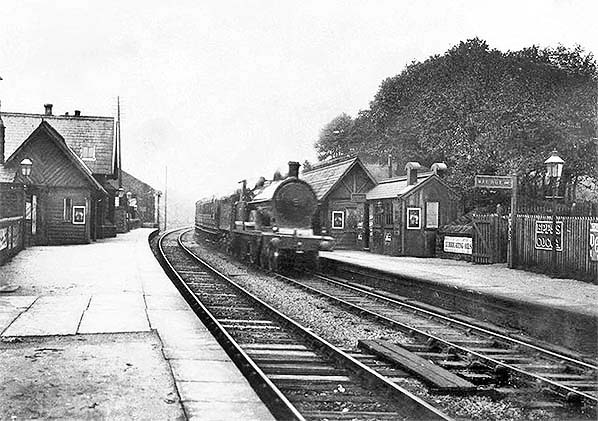

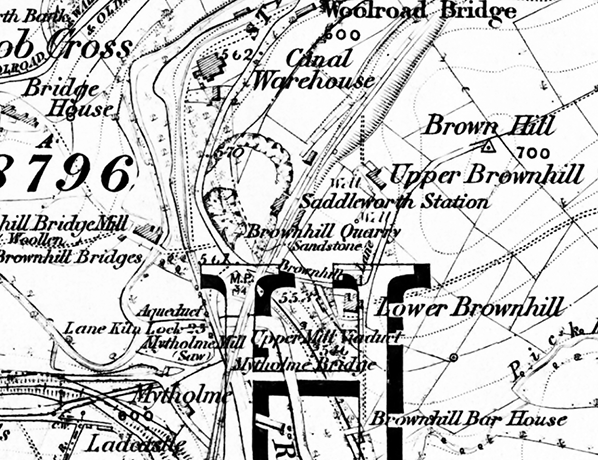
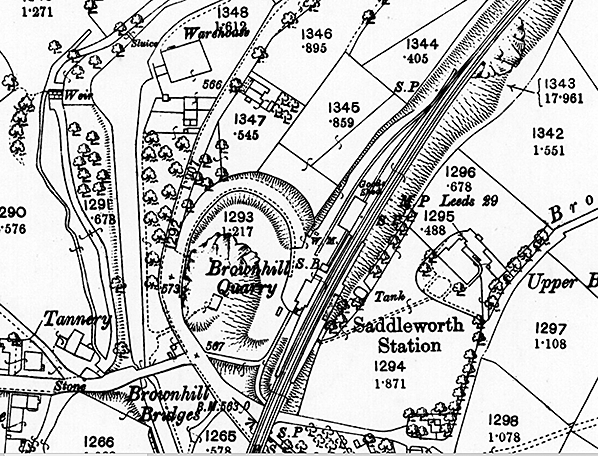 1893 1: 2,500 OS map. The station approach road curves around Brownhill Quarry to reach the main building of Saddleworth station located on the down (north-west) platform. The signal box is placed immediately north-east of the main building. Beyond the platform are two sidings, one passing through the goods warehouse. On the facing up platform is a waiting shed. No access is shown to this platform; passengers must cross the two railway tracks to reach it.
1893 1: 2,500 OS map. The station approach road curves around Brownhill Quarry to reach the main building of Saddleworth station located on the down (north-west) platform. The signal box is placed immediately north-east of the main building. Beyond the platform are two sidings, one passing through the goods warehouse. On the facing up platform is a waiting shed. No access is shown to this platform; passengers must cross the two railway tracks to reach it.
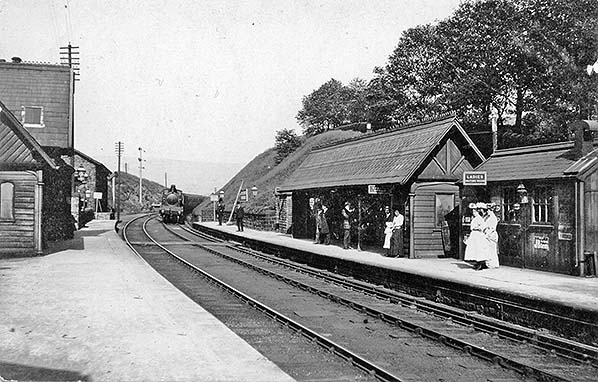 Saddleworth station looking north-east c1906 from the down platform. Smartly attired passengers wait on the up platform, some of them taking advantage of the commodious, open-fronted timber waiting shed which, as the sign shows, also contains a booking office. Beyond this shed are the stone-built gents’ toilet and a running-in nameboard reading ‘Saddleworth for Dobcross’. To the right of the larger building is the smaller timber structure of the ladies’ waiting room. The main station building is on the down platform, its overhanging gable visible, far left, beyond a timber waiting room. Beyond the end of the platform is the stone-built goods warehouse. The approaching southbound passenger train is led by either a ‘Jubilee’ or ‘Alfred the Great’ class loco hauling what appears to be a van, followed by a six-wheel carriage then two eight-wheel radial or bogie carriages, all LNWR stock.
Saddleworth station looking north-east c1906 from the down platform. Smartly attired passengers wait on the up platform, some of them taking advantage of the commodious, open-fronted timber waiting shed which, as the sign shows, also contains a booking office. Beyond this shed are the stone-built gents’ toilet and a running-in nameboard reading ‘Saddleworth for Dobcross’. To the right of the larger building is the smaller timber structure of the ladies’ waiting room. The main station building is on the down platform, its overhanging gable visible, far left, beyond a timber waiting room. Beyond the end of the platform is the stone-built goods warehouse. The approaching southbound passenger train is led by either a ‘Jubilee’ or ‘Alfred the Great’ class loco hauling what appears to be a van, followed by a six-wheel carriage then two eight-wheel radial or bogie carriages, all LNWR stock.
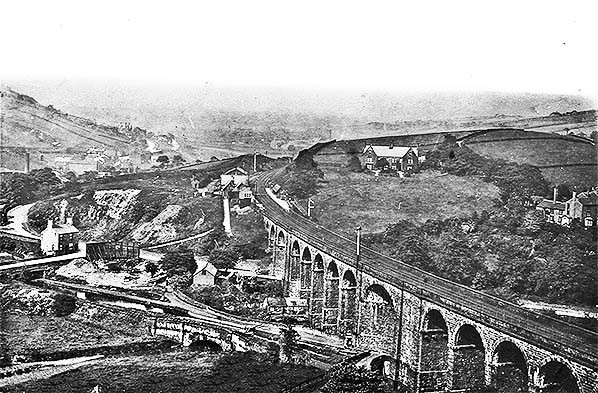
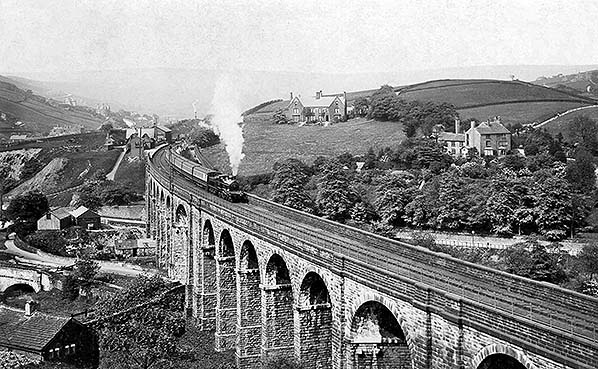
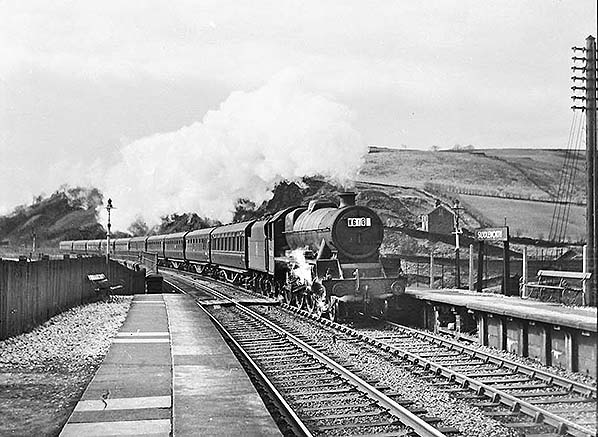
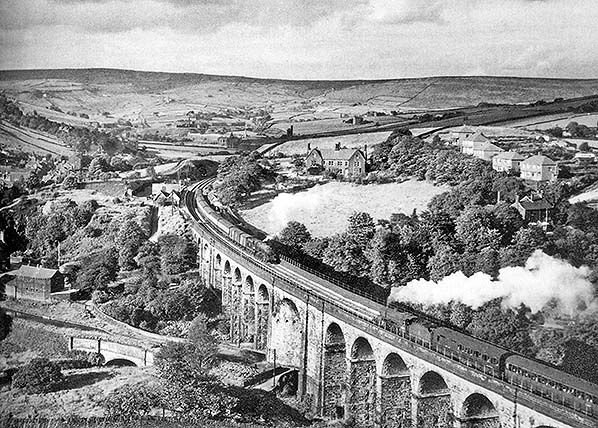

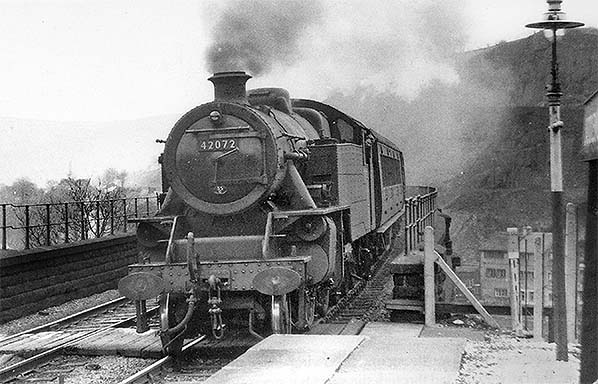
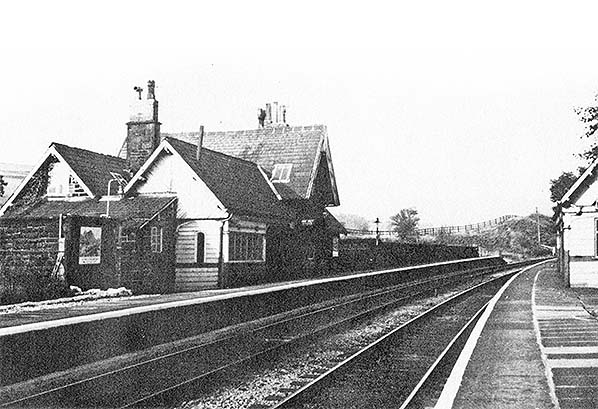

 When the Huddersfield & Manchester Railway opened to passengers on 1 August 1849 two of the stations were within the parish of Saddleworth; one was named Greenfield and the other Saddleworth. In the LNWR timetable of 1852 Saddleworth was named ‘Saddleworth Upper Mill’ but by 1864 this timetable had dropped ‘Upper Mill’ from the name. On the same route
When the Huddersfield & Manchester Railway opened to passengers on 1 August 1849 two of the stations were within the parish of Saddleworth; one was named Greenfield and the other Saddleworth. In the LNWR timetable of 1852 Saddleworth was named ‘Saddleworth Upper Mill’ but by 1864 this timetable had dropped ‘Upper Mill’ from the name. On the same route  The stations between Huddersfield and Stalybridge were described by the Manchester Examiner as being ‘in the Tudor style’ and that they ‘will have a picturesque effect when completed; the pointed architecture harmonises so well with the abrupt pointed scenery around’. This description applies to Saddleworth inasmuch as its principal building was picturesque, and it harmonised with the scenery around by virtue of being constructed of local sandstone; however it was the blackened masonry – the product of decades of smoke-polluted air – that provided harmony with all of the stone buildings throughout the upper Tame valley. The station’s character was distinctly rural in comparison to the others on the line which were provided with substantial platform roofing.
The stations between Huddersfield and Stalybridge were described by the Manchester Examiner as being ‘in the Tudor style’ and that they ‘will have a picturesque effect when completed; the pointed architecture harmonises so well with the abrupt pointed scenery around’. This description applies to Saddleworth inasmuch as its principal building was picturesque, and it harmonised with the scenery around by virtue of being constructed of local sandstone; however it was the blackened masonry – the product of decades of smoke-polluted air – that provided harmony with all of the stone buildings throughout the upper Tame valley. The station’s character was distinctly rural in comparison to the others on the line which were provided with substantial platform roofing. The station’s signal box was at first located on the down platform north-east of the passenger buildings; however this was replaced with a box south-west of the buildings as seen on the accompanying photographs.
The station’s signal box was at first located on the down platform north-east of the passenger buildings; however this was replaced with a box south-west of the buildings as seen on the accompanying photographs.

 The Huddersfield – Manchester railway was originally double track (although, at first, single through Standedge Tunnel) but the volume of passenger, goods and mineral traffic grew to such a degree that the LNWR decided to add two more tracks. The sides of the Colne Valley between Huddersfield and the Standedge Tunnels were steep and, in places, built upon, but it was possible to quadruple this section and provide two additional platform faces at Longwood, Golcar, Slaithwaite and Marsden stations; this work was done between 1883 and 1894. An additional double-track bore was added to the two existing single-track Standedge Tunnels and at
The Huddersfield – Manchester railway was originally double track (although, at first, single through Standedge Tunnel) but the volume of passenger, goods and mineral traffic grew to such a degree that the LNWR decided to add two more tracks. The sides of the Colne Valley between Huddersfield and the Standedge Tunnels were steep and, in places, built upon, but it was possible to quadruple this section and provide two additional platform faces at Longwood, Golcar, Slaithwaite and Marsden stations; this work was done between 1883 and 1894. An additional double-track bore was added to the two existing single-track Standedge Tunnels and at  In its early years Bradshaw timetables indicated that Saddleworth was one of the more important stations between Leeds and Manchester using bold type for the name and indicating (in the March 1850 edition) that all trains called, which was not the case for some of the other intermediate stations. The service of seven weekday and three Sunday trains (plus one which ran only on Tuesday, Thursday and Saturday only) was spaced fairly evenly throughout the day. The February 1863 and August 1887 timetables showed a similar frequency of service. As seen below by April 1910 the weekday level of service had improved.
In its early years Bradshaw timetables indicated that Saddleworth was one of the more important stations between Leeds and Manchester using bold type for the name and indicating (in the March 1850 edition) that all trains called, which was not the case for some of the other intermediate stations. The service of seven weekday and three Sunday trains (plus one which ran only on Tuesday, Thursday and Saturday only) was spaced fairly evenly throughout the day. The February 1863 and August 1887 timetables showed a similar frequency of service. As seen below by April 1910 the weekday level of service had improved.  The station carried nameboards reading ‘Saddleworth for Dobcross’ for some time until the early years of the twentieth century, and Bradshaw timetables gave the station name in this form. However in 1912 the LNWR added three stations to be served by Delph – Greenfield – Oldham trains, and one of these was Dobcross on the Delph branch (which left the main line a short distance south of Saddleworth station). Thereafter ‘Dobcross’ was dropped from Saddleworth’s name, but it is not known how long it was before the station nameboards were altered or replaced.
The station carried nameboards reading ‘Saddleworth for Dobcross’ for some time until the early years of the twentieth century, and Bradshaw timetables gave the station name in this form. However in 1912 the LNWR added three stations to be served by Delph – Greenfield – Oldham trains, and one of these was Dobcross on the Delph branch (which left the main line a short distance south of Saddleworth station). Thereafter ‘Dobcross’ was dropped from Saddleworth’s name, but it is not known how long it was before the station nameboards were altered or replaced. Throughout its life Saddleworth station retained its Victorian, rural character. The LNWR raised the original, low platforms to standard height. Gas lighting was retained, but casement lanterns were replaced with Sugg-style lamps either by the LMS (which operated the station from the Grouping of 1923) or British Railways (London Midland Region) after Nationalisation in 1948; this style of lamp, seen on later photographs, was distinctive of LMS/BR(LM) practice. BR(LM) totem nameplates of a fully-flanged design were installed after 1957 together with running-in nameboards also in vitreous enamel. Black-and-white ‘Corporate Identity’ signage, introduced by British Rail in 1965, was not installed at Saddleworth.
Throughout its life Saddleworth station retained its Victorian, rural character. The LNWR raised the original, low platforms to standard height. Gas lighting was retained, but casement lanterns were replaced with Sugg-style lamps either by the LMS (which operated the station from the Grouping of 1923) or British Railways (London Midland Region) after Nationalisation in 1948; this style of lamp, seen on later photographs, was distinctive of LMS/BR(LM) practice. BR(LM) totem nameplates of a fully-flanged design were installed after 1957 together with running-in nameboards also in vitreous enamel. Black-and-white ‘Corporate Identity’ signage, introduced by British Rail in 1965, was not installed at Saddleworth. The ‘Beeching Report’ of 1963 identified certain routes as main lines on which local trains calling at minor stations would congest the paths of longer-haul express services: the Leeds City – Huddersfield – Manchester Victoria – Liverpool Lime Street route was such a route. Although between Huddersfield and Stalybridge there were still four tracks (two via Micklehurst, two via Saddleworth) so that fast and slow trains, passenger and goods, could undoubtedly have been accommodated, Beeching proposed to close all stations between Huddersfield and Manchester with the sole exception of Stalybridge. Whilst many ‘Beeching’ closures were effected by 1966, the Leeds – Liverpool proposal took over five years to be completed, and several stations were reprieved; Saddleworth was not one of them. Greenfield (about 1¼ miles south of Saddleworth station) was retained as the ‘railhead’ to serve the Saddleworth area. The opportunity to demote Saddleworth station or any of its neighbours threatened with closure to ‘unstaffed halts’ to reduce costs was not taken. Marsden (immediately north-east of Standedge Tunnel) survived the purge of local stations, but even it would remain partially staffed until September 1975 when staffing was discontinued.
The ‘Beeching Report’ of 1963 identified certain routes as main lines on which local trains calling at minor stations would congest the paths of longer-haul express services: the Leeds City – Huddersfield – Manchester Victoria – Liverpool Lime Street route was such a route. Although between Huddersfield and Stalybridge there were still four tracks (two via Micklehurst, two via Saddleworth) so that fast and slow trains, passenger and goods, could undoubtedly have been accommodated, Beeching proposed to close all stations between Huddersfield and Manchester with the sole exception of Stalybridge. Whilst many ‘Beeching’ closures were effected by 1966, the Leeds – Liverpool proposal took over five years to be completed, and several stations were reprieved; Saddleworth was not one of them. Greenfield (about 1¼ miles south of Saddleworth station) was retained as the ‘railhead’ to serve the Saddleworth area. The opportunity to demote Saddleworth station or any of its neighbours threatened with closure to ‘unstaffed halts’ to reduce costs was not taken. Marsden (immediately north-east of Standedge Tunnel) survived the purge of local stations, but even it would remain partially staffed until September 1975 when staffing was discontinued.
 The timetable (below) would prove to be the last for Saddleworth. The long gap between the northbound 08.14 and 15.39 departures on Monday-to-Friday is conspicuous and there is a four-hour gap in the afternoon in southbound services. However on Saturday provision is made for shopping and leisure trips in the middle of the day. Perhaps ominously, this is the first timetable in which no service is provided on Sunday.
The timetable (below) would prove to be the last for Saddleworth. The long gap between the northbound 08.14 and 15.39 departures on Monday-to-Friday is conspicuous and there is a four-hour gap in the afternoon in southbound services. However on Saturday provision is made for shopping and leisure trips in the middle of the day. Perhaps ominously, this is the first timetable in which no service is provided on Sunday. On Monday 7 October 1968 Saddleworth was formally closed to all traffic, the coal depot (all that remained of its goods facilities) having ceased to operate on 5 June 1961. The buildings and platforms of most of the stations which closed with Saddleworth, including Longwood, Golcar, Slaithwaite and Diggle were demolished within several years; even the surviving stations at Marsden and Greenfield lost their buildings by the mid 1970s. The platforms at Saddleworth had been largely demolished by autumn 1970 and the buildings on the up platform had been removed, but the main building on the down platform remained in place, no doubt because of its robust construction, architectural charm and suitability for the residential use. The waiting room and ticket office were converted to a living room and the goods yard became a garden. In 1978, television director
On Monday 7 October 1968 Saddleworth was formally closed to all traffic, the coal depot (all that remained of its goods facilities) having ceased to operate on 5 June 1961. The buildings and platforms of most of the stations which closed with Saddleworth, including Longwood, Golcar, Slaithwaite and Diggle were demolished within several years; even the surviving stations at Marsden and Greenfield lost their buildings by the mid 1970s. The platforms at Saddleworth had been largely demolished by autumn 1970 and the buildings on the up platform had been removed, but the main building on the down platform remained in place, no doubt because of its robust construction, architectural charm and suitability for the residential use. The waiting room and ticket office were converted to a living room and the goods yard became a garden. In 1978, television director 
 Home Page
Home Page